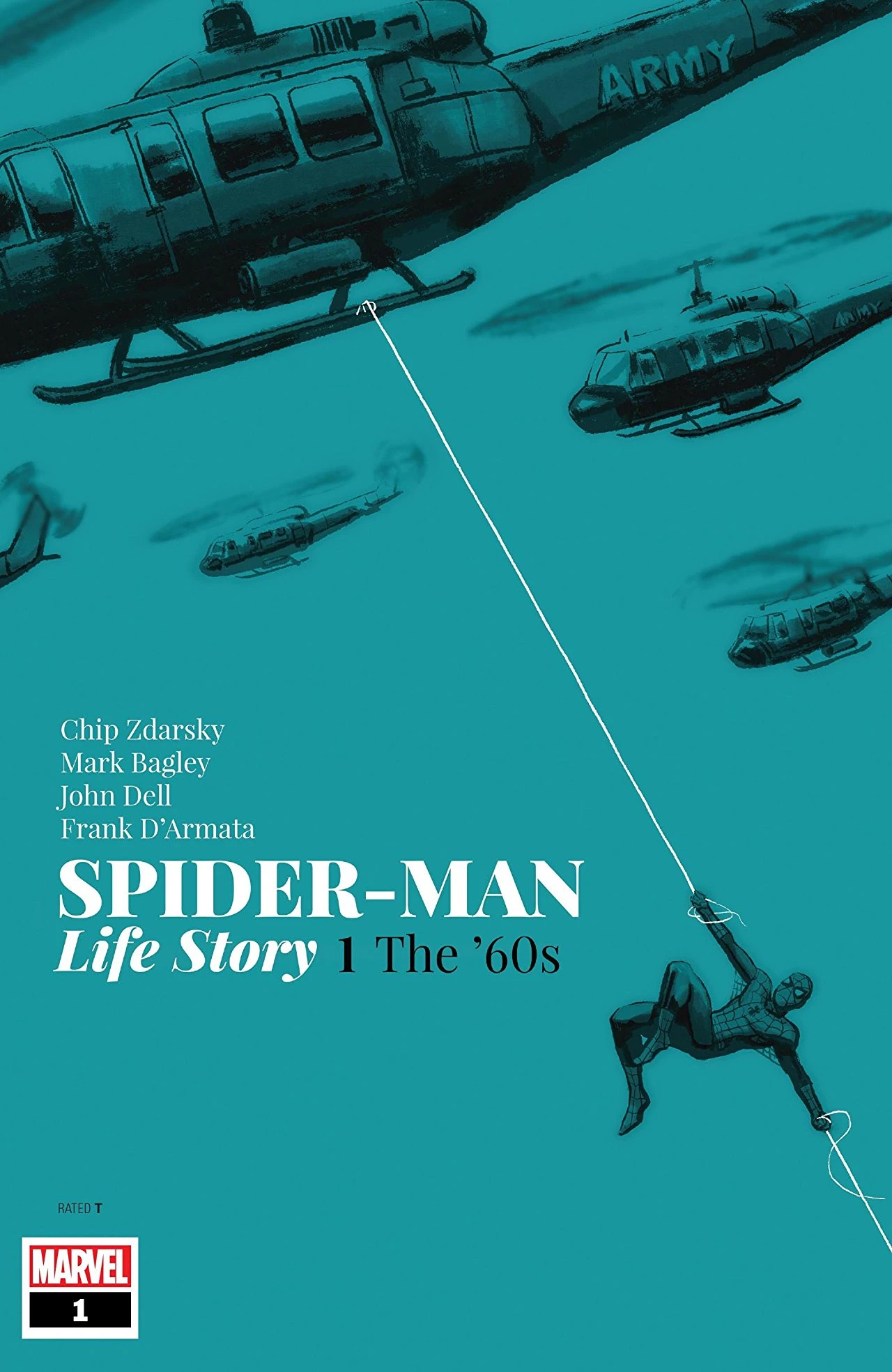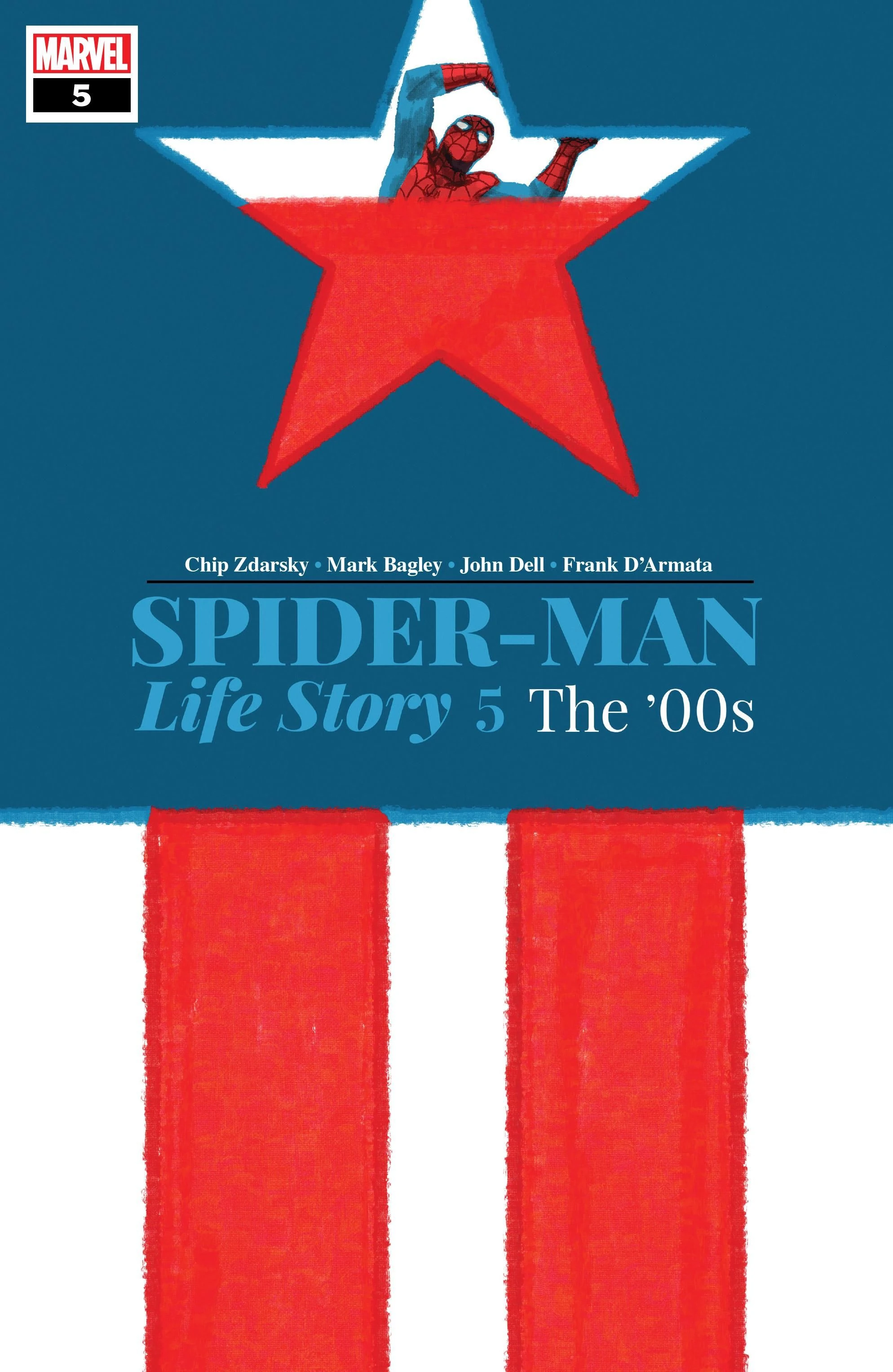In Marvel Comics, most of their heroes came into existence back in the Sixties and have remained ageless ever since to maintain their appeal. Spider-Man was a different case though – fans watched Peter Parker grow up from teenager to young man throughout the years until Marvel halted his aging when he got to his mid-twenties. The purpose was to depict him as an Everyman; someone who led an extraordinary life yet had experiences that we could all connect to.

But in the new mini-series Spider-Man: Life Story, writer Chip Zdarsky and artist Mark Bagley surmise what would have happened to Spidey, had he kept aging in real time. The results? Life Story is a dark and twisty tale that cleverly incorporates nearly all the major milestones in the character’s 57-year long history. Each issue spotlights Spidey’s life in a different decade, starting with the Sixties all the way to the Tens.
After a quick one-page origin sequence (ala All-Star Superman by Grant Morrison and Frank Quitely), Zdarsky and Bagley throw readers right into Spidey’s life where Peter is already in college. While the story starts off like a nostalgia trip revisiting Stan Lee’s classic run, by the end of the first issue things start to take a radical turn. The classic Spider-Man dilemmas are still there such as how can Peter balance his college life while fighting super villains. But Zdarsky throws in a new layer – bringing real world issues of each decade to the forefront – in the first issue, it’s the Vietnam War. When Flash Thompson is drafted into the controversial war, Peter questions whether Spider-Man himself should enlist as well. Searching for the answer weighs heavily on Peter who is all about responsibility.
While Marvel Comics have always acknowledged real world issues in the past, it’s rare that its characters tackle these topics head on. If there’s one major critique about super heroes in comic books it’s that though they save the world, they don’t create real change and preserve the status quo. In Life Story the Avengers do get involved (albeit, in unexpected ways) in Vietnam. Spider-Man does make a decision about his involvement but the outcome haunts him. Zdarsky’s heroes don’t sit on the sidelines on issues and try to effect change for better or worse. The utilization of world events over the last 60 years provides a wealth of story material and controversial issues that help to drive Life Story’s intriguing storyline.

What makes Life Story’s “realistic” setting even more compelling is that there are consequences to characters’ actions that not only affect the characters but the world around them. It’s pure genius to see how the Cold War ties into the Marvel event, Secret War. The outcome there is eerily haunting.
While it showcases a Marvel Universe unlike any other, this is still first and foremost a Spider-Man story – one of the grimmest and toughest stories that the character has ever been in. Spidey and his supporting cast are put through a relentless grinder without any mercy. It can be argued that the character is a better fit for lighter adventures but long-time fans will tell you that one of the best Spider-Man stories is Kraven’s Last Hunt, a gritty and disturbing tale (which gets a nod in this series as well). Every chapter in this series has that flavor while staying true to one of Spider-Man’s key character traits – his tenacity to overcome tough times. All the characters in his universe are quintessentially the same, just situated in some of the hardest predicaments. Mary Jane. Aunt May. Flash Thompson. Gwen Stacy. Harry Osborn. Spidey’s enemies. Other Marvel heroes. No one is spared.

The fun of each issue is catching up with Peter at different phases in his life, which are loosely based on the most prominent Spider-Man storylines that occurred in that specific decade. In the 70s issue, it’s Peter in his twenties finding work as a scientist, newly married, and dealing with a new Goblin. The 80s chapter has him dealing with the fallout from Secret Wars and facing Venom in a surprising way. Zdarsky and Bagley lets the age issue start to weigh heavier and heavier with each chapter – it’s brilliantly depicted through Aunt May and through Peter’s physicality until it can’t be ignored anymore. Veteran Spider-Man artist Mark Bagley is the perfect collaborator for Life Story since he’s been drawing the character for 30 years. His character designs are refreshingly new while keeping faithful to their cores and his dramatic sequences are as fluid and kinetic as ever.

Jam-packed with story, readers will definitely get their money’s worth with each issue. Though many of the storylines found in this series are familiar, it’s the way Zdarsky and Bagley remixes them into this slick and seamless tapestry that makes the story ingenious. New and old fans won’t see the twists coming. With two issues left in the series to go, there’s still time for new reader to catch up. Highly recommended.

About the author:

JV Tanjuatco, comic book writer/editor/publisher, founded Comic Book Lab that publishes the comic book titles Mythopolis and War of Whispers (co-created and co-written by him). Comic Book Lab’s most recent project was the graphic novel anthology Stay: 21 Comic Stories authored by Palanca Award winner Angelo R. Lacuesta and illustrated by a stellar line-up of artists including Trese’s Kajo Baldisimo. He has also written articles/reviews for Spot.ph and Ain’t It Cool.










